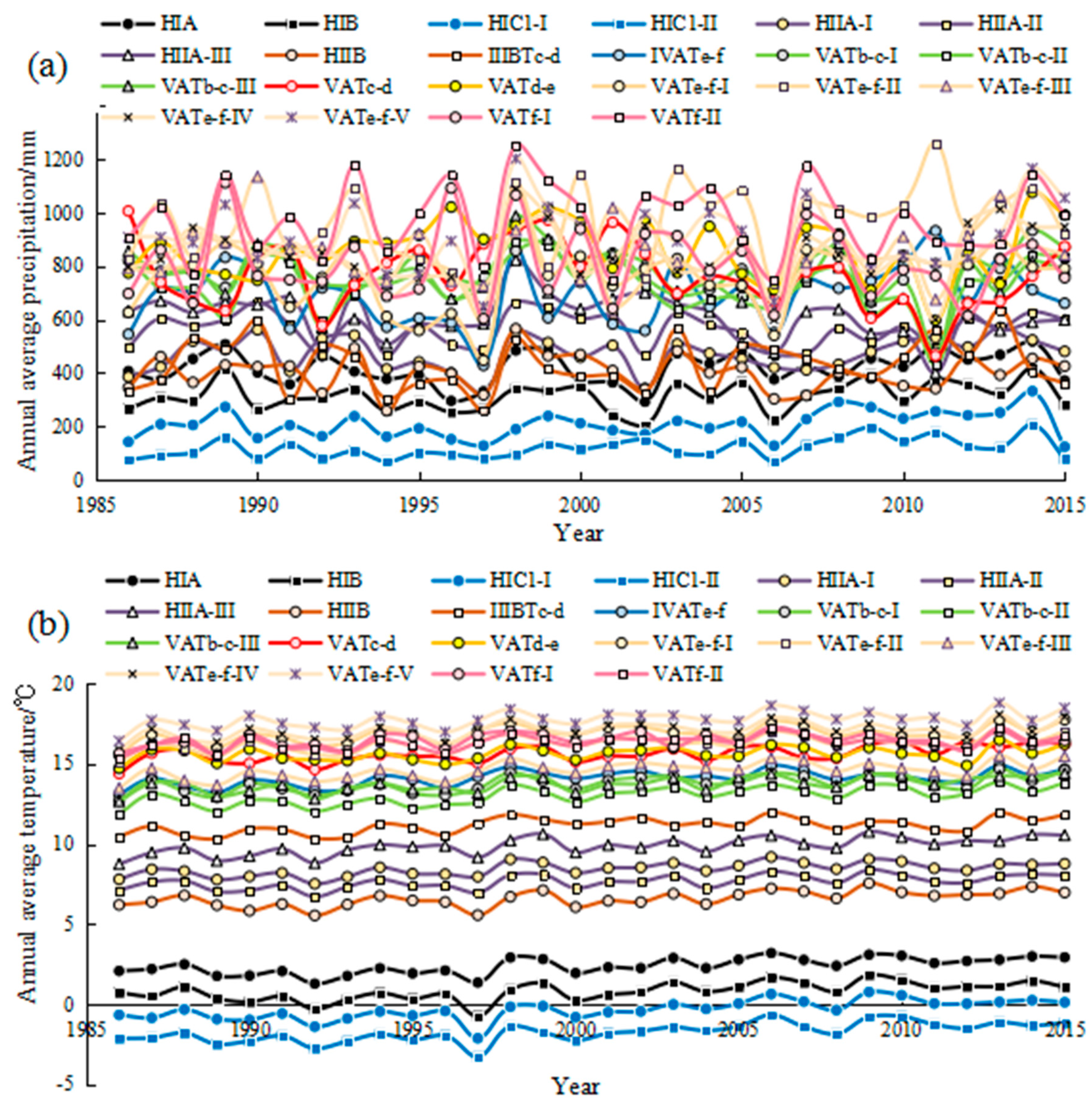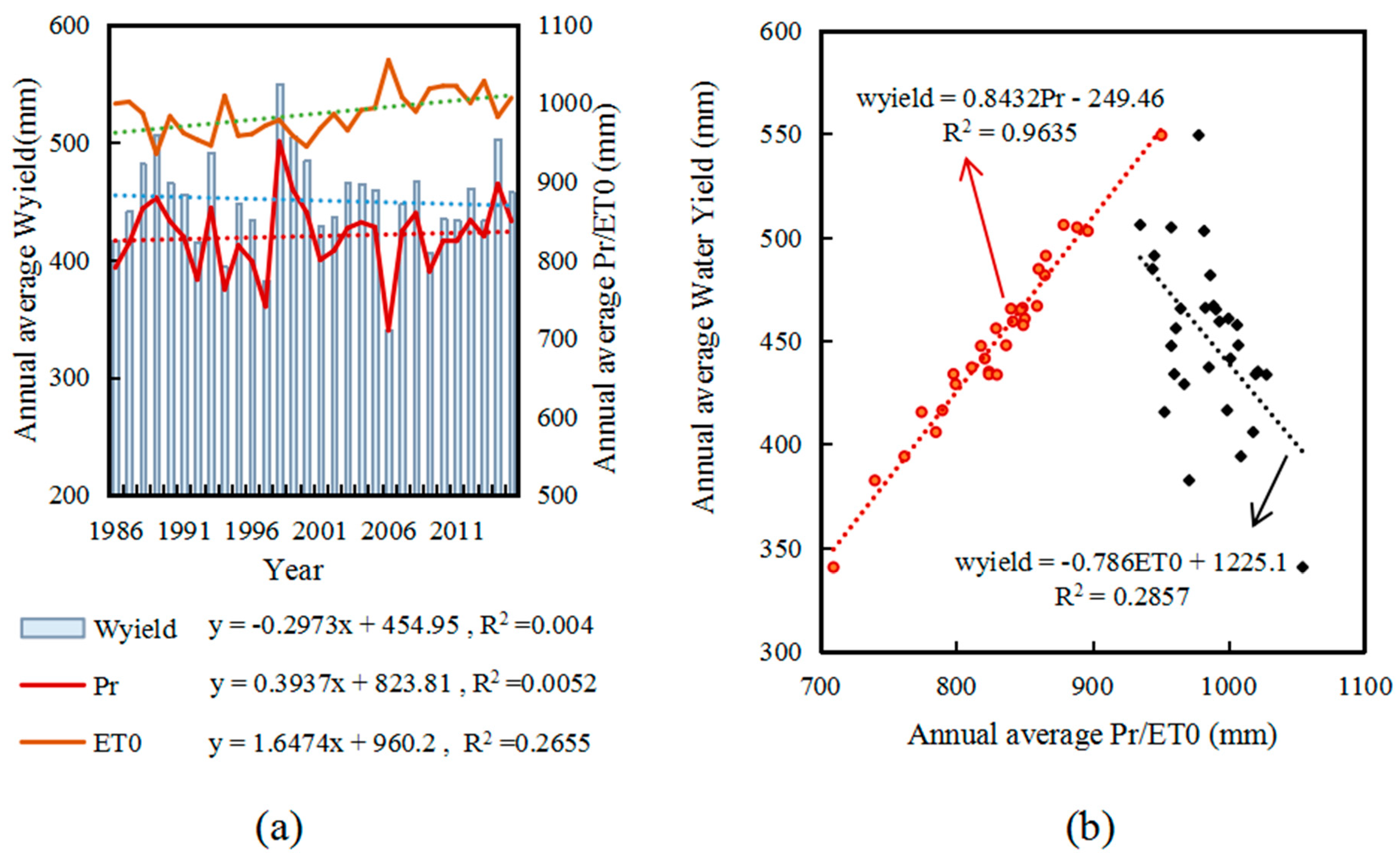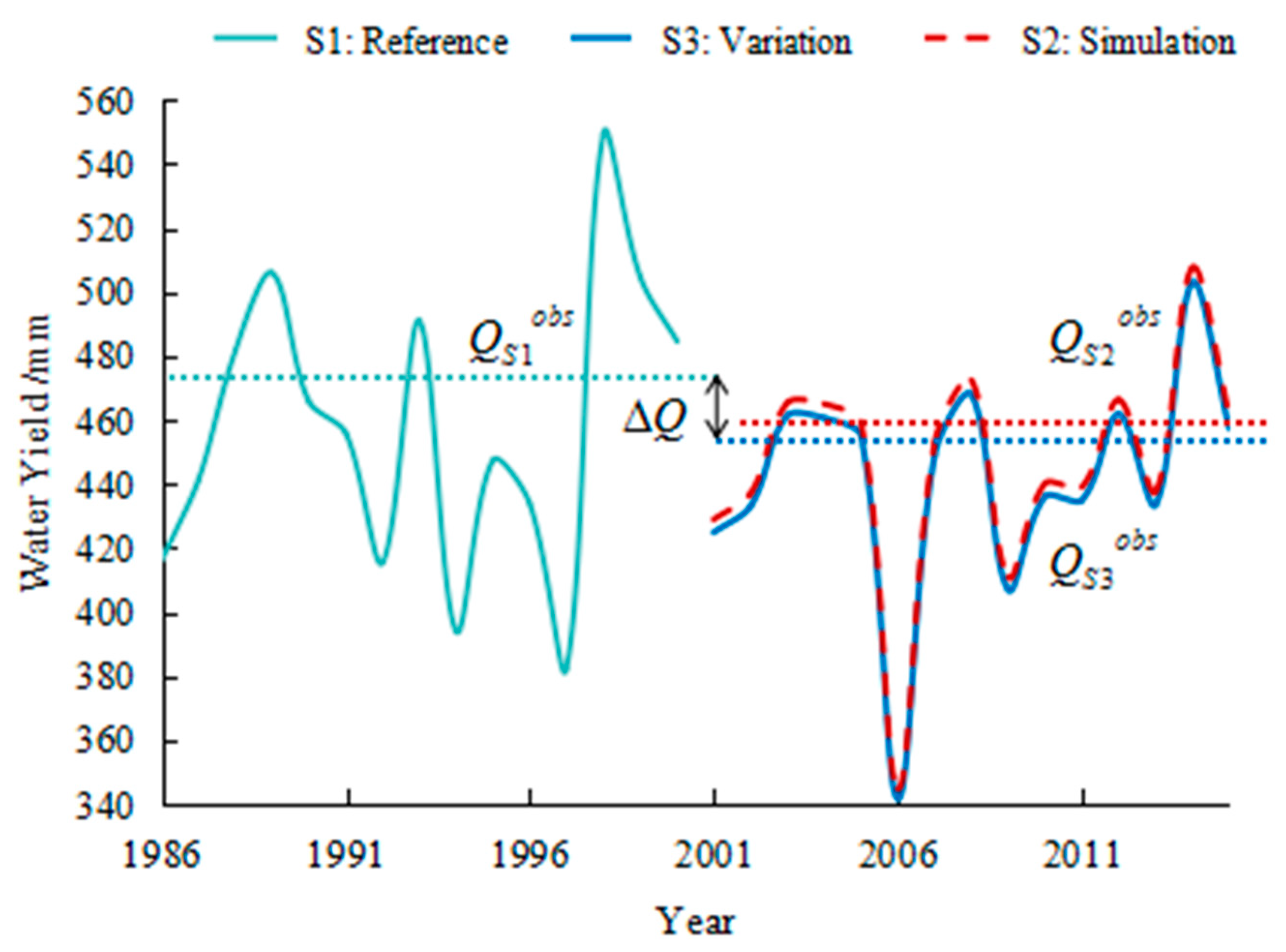Regional Impacts of Climate and Land Cover on Ecosystem Water Retention Services in the Upper Yangtze River Basin
Abstract
:1. Introduction
2. Materials and Methods
2.1. Study Area
2.2. Data
2.3. Scenario Analysis to Quantify the Impacts of Climate and Land Cover Change on Water Retention
2.4. Water Retention Model
2.5. Potential Evapotranspiration (ET0) Calculation
2.6. Climate Zone
2.7. Statistical Analysis
3. Results
3.1. Climate Change
3.2. Land-Cover Change
3.3. Spatiotemporal Variation Characteristics of Water Yield
3.4. Impact of Climate and Land Cover on Water Yield
4. Discussion
4.1. Regional Variability
4.2. Adaptive Management
4.3. Limitations
5. Conclusions
Author Contributions
Funding
Conflicts of Interest
References
- MEA. Millennium Ecosystem Assessment: Ecosystems and Human Well-Being: A Framework for Assessment; Island Press: Washington, DC, USA, 2003. [Google Scholar]
- Costanza, R. Ecosystem services: Multiple classification systems are needed. Conserv. Biol 2008, 141, 350–352. [Google Scholar] [CrossRef]
- Fisher, B.; Turner, R.K.; Morling, P. Defining and classifying ecosystem services for decision making. Ecol. Econ. 2009, 68, 643–653. [Google Scholar] [CrossRef] [Green Version]
- MEA. Millennium Ecosystem Assessment. Ecosystems and Human Well-Being: Synthesis; Island Press: Washington, DC, USA, 2005. [Google Scholar]
- Schroter, M.; Albert, C.; Marques, A. National Ecosystem Assessments in Europe: A Review. BioScience 2016, 66, 813–828. [Google Scholar] [CrossRef] [Green Version]
- Ouyang, Z.; Zheng, H.; Xiao, Y.; Polasky, S.; Liu, J.; Xu, W.; Wang, Q.; Zhang, L.; Xiao, Y.; Rao, E.; et al. Improvements in ecosystem services from investments in natural capital. Science 2016, 352, 1455–1459. [Google Scholar] [CrossRef]
- Future, E. Future Earth Initial Design; International Council for Science (ICSU): Paris, France, 2013. [Google Scholar]
- Piao, S.; Ciais, P.; Huang, Y.; Shen, Z.; Peng, S.; Li, J.; Zhou, L.; Liu, H.; Ma, Y.; Ding, Y.; et al. The impacts of climate change on water resources and agriculture in China. Nature 2010, 467, 43–51. [Google Scholar] [CrossRef]
- Arnell, N.W.; Lloyd-Hughes, B. The global-scale impacts of climate change on water resources and flooding under new climate and socio-economic scenarios. Clim. Chang. 2014, 122, 127–140. [Google Scholar] [CrossRef]
- Runting, R.K.; Bryan, B.A.; Dee, L.E.; Maseyk, F.J.F.; Mandle, L.; Hamel, P.; Wilson, K.A.; Yetka, K.; Possingham, H.P.; Rhodes, J.R. Incorporating climate change into ecosystem service assessments and decisions: A review. Glob. Chang. Biol. 2016, 23, 28–41. [Google Scholar] [CrossRef]
- Yin, Y.H.; Wu, S.H.; Zhao, D.S.; Dai, E.F. Ecosystem water conservation changes in response to climate change in the Source Region of the Yellow River from 1981 to 2010. Geogr. Res. 2016, 35, 49–57. [Google Scholar]
- Nie, Y.H.; Gong, B.; Li, Z. The spatial-temporal variations of water conservation capacity in Qinghai-Tibet Plateau. Earth Sci. Front. 2010, 17, 373–377. [Google Scholar]
- Pan, T.; Wu, S.H.; Dai, E.F.; Liu, Y.J. Spatiotemporal variation of water source supply service in Three Rivers Source Area of China based on InVEST model. Chin. J. Appl. Ecol. 2013, 24, 183–189. [Google Scholar]
- Fu, B.J.; Zhang, L.W. Land-use change and ecosystem services: Concepts, methods and progress. Prog. Geogr. 2014, 33, 441–446. [Google Scholar]
- Guo, Y.F. Land Use Change and Its Influence on Water Conservation Service Based on CLUE in Jiangxi Province. Master’s Thesis, Anhui Normal University, Hefei, China, 2011. [Google Scholar]
- Zeng, L.; Li, J.; Li, T.; Yang, X.N.; Wang, Y.Z. Optimizing spatial patterns of water conservation ecosystem service based on Bayesian belief networks. Acta Geogr. Sin. 2018, 73, 1809–1822. [Google Scholar]
- Ray, D.; Bathgate, S.; Moseley, D.; Taylor, P.; Nicoll, B.; Pizzirani, S.; Gardiner, B. Comparing the provision of ecosystem services in plantation forests under alternative climate change adaptation management options in Wales. Reg. Environ. Chang. 2015, 15, 1501–1513. [Google Scholar] [CrossRef]
- Tulbure, M.G.; Broich, M. Spatiotemporal patterns and effects of climate and land use on surface water extent dynamics in a dryland region with three decades of Landsat satellite data. Sci. Total Environ. 2019, 658, 1574–1585. [Google Scholar] [CrossRef]
- Villamizar, S.R.; Pineda, S.M.; Carrillo, G.A. The Effects of Land Use and Climate Change on the Water Yield of a Watershed in Colombia. Water 2019, 11, 19. [Google Scholar] [CrossRef]
- Op de Hipt, F.; Diekkruger, B.; Steup, G.; Yira, Y.; Hoffmann, T.; Rode, M.; Naschen, K. Modeling the effect of land use and climate change on water resources and soil erosion in a tropical West African catch-ment (Dano, Burkina Faso) using SHETRAN. Sci. Total Environ. 2019, 653, 431–445. [Google Scholar] [CrossRef]
- Tamm, O.; Maasikamae, S.; Padari, A.; Tamm, T. Modelling the effects of land use and climate change on the water resources in the eastern Baltic Sea region using the SWAT model. Catena 2018, 167, 78–89. [Google Scholar] [CrossRef]
- Hutchins, M.G.; Abesser, C.; Prudhomme, C.; Elliott, J.A.; Bloomfield, J.P.; Mansour, M.M.; Hitt, O.E. Combined impacts of future land-use and climate stressors on water resources and quality in groundwater and surface waterbodies of the upper Thames river basin, UK. Sci. Total Environ. 2018, 631, 962–986. [Google Scholar] [CrossRef]
- Tsarouchi, G.; Buytaert, W. Land-use change may exacerbate climate change impacts on water resources in the Ganges basin. Hydrol. Earth Syst. Sci. 2018, 22, 1411–1435. [Google Scholar] [CrossRef]
- Wang, Y.Q.; Yang, X.L.; Ren, L.L.; Zhang, M.R. Variation trend analysis of temperature, precipitation and drought in upper Yangtze River Basin. Yangtze River 2017, 48, 39–44. [Google Scholar]
- Hong, G.P.; Xiao, Y.; Chen, L.H. Evaluation and projection of climate change over the Upper Yangtze River in sres scenarios. Resour. Environ. Yangtze Basin 2013, 22, 894–899. [Google Scholar]
- Zhang, L.; Cheng, L.; Chiew, F.; Fu, B.J. Understanding the impacts of climate and landuse change on water yield. Curr. Opin. Environ. Sustain. 2018, 33, 167–174. [Google Scholar] [CrossRef]
- Green, P.A.; Vörösmarty, C.J.; Harrison, I.; Farrell, T.; Sáenz, L.; Fekete, B.M. Freshwater ecosystem services supporting humans: Pivoting from water crisis to water solutions. Glob. Environ. Chang. 2015, 34, 108–118. [Google Scholar] [CrossRef]
- Leh, M.D.K.; Matlock, M.D.; Cummings, E.C.; Nalley, L.L. Quantifying and mapping multiple ecosystem services change in West Africa. Agr. Ecosyst. Environ. 2013, 165, 6–18. [Google Scholar] [CrossRef]
- Vigerstol, K.L.; Aukema, J.E. A comparison of tools for modeling freshwater ecosystem services. J. Environ. Manag. 2011, 92, 2403–2409. [Google Scholar] [CrossRef]
- Hoyer, R.; Chang, H. Assessment of freshwater ecosystem services in the Tualatin and Yamhill basins under climate change and urbanization. Appl. Geogr. 2014, 53, 402–416. [Google Scholar] [CrossRef]
- Tallis, H.T.; Ricketts, T.; Guerry, A.D. InVEST 2.4.1 User’s Guide; The Natural Capital Project: Stanford, CA, USA, 2011. [Google Scholar]
- Trisurat, Y.; Eawpanich, P.; Kalliola, R. Integrating land use and climate change scenarios and models into assessment of forested watershed services in Southern Thailand. Environ. Res. 2016, 147, 611–620. [Google Scholar] [CrossRef]
- Chen, L.; Xie, G.; Zhang, C.; Pei, S.; Fan, N.; Ge, L.; Zhang, C. Modeling ecosystem water supply services across the. Lancang River basin. J. Resour. Ecol. 2011, 2, 322–327. [Google Scholar]
- Zhang, C.Q.; Li, W.H.; Zhang, B.; Liu, M.C. Water yield of Xitiaoxi River Basin based on InVEST modeling. J. Resour. Ecol. 2012, 3, 50–54. [Google Scholar]
- Zhang, L.; Dawes, W.R.; Walker, G.R. Response of mean annual evapotranspiration to vegetation changes atchment scale. Water Resour. Res. 2001, 37, 701–708. [Google Scholar] [CrossRef]
- Allen, R.L.; Pereira, D.R.; Smith, M. Crop Evapotranspiration Guidelines for Computing Crop Water Requirements; FAO: Rome, Italy, 1998. [Google Scholar]
- Zheng, J.Y.; Yin, Y.H.; Li, B.Y. A New Scheme for Climate Regionalization in China. Acta Geogr. Sin. 2010, 65, 3–12. [Google Scholar]
- Zhu, D.L. Methods for Detecting Land Use Changes Based on the Land Use Transition Matrix. Resour. Sci. 2010, 32, 1544–1550. [Google Scholar]
- Mekonnen, D.F.; Duan, Z.; Rientjes, T.; Disse, M. Analysis of combined and isolated effects of land-use and land-cover changes and climate change on the upper Blue Nile River basin’s streamflow. Hydrol. Earth Syst. Sci. 2018, 22, 6187–6207. [Google Scholar] [CrossRef]
- Zhao, G.J.; Tian, P.; Mu, X.M.; Jiao, J.Y.; Wang, F.; Gao, P. Quantifying the impact of climate variability and human activities on streamflow in the middle reaches of the Yellow River basin, China. J. Hydrol. 2014, 519, 387–398. [Google Scholar] [CrossRef]
- Liang, W.; Bai, D.; Jin, Z.; You, Y.C.; Li, J.X.; Yang, Y.T. A Study on the Streamflow Change and its Relationship with Climate Change and Ecological Restoration Measures in a Sediment. Concentrated Region in the Loess Plateau, China. Water Resour. Manag. 2015, 29, 4045–4060. [Google Scholar] [CrossRef]
- Zhou, G.; Wei, X.; Chen, X.; Zhou, P.; Liu, X.; Xiao, Y.; Sun, G.; Scott, D.F.; Zhou, S.; Han, L.; et al. Global pattern for the effect of climate and land cover on water yield. Nat. Commun. 2015, 6, 5918. [Google Scholar] [CrossRef] [PubMed]
- Marquès, M.; Bangash, R.F.; Kumar, V.; Sharp, R.; Schuhmacher, M. The impact of climate change on water provision under a low flow regime: A case study of the ecosystems. services in the Francoli river basin. J. Hazard. Mater. 2013, 263, 224–232. [Google Scholar] [CrossRef]
- Long, T.T.; Duong, C.C.; Steen, P.V.D.; Lens, P.N.L. Exploring the potential for wastewater reuse in agriculture as a climate change adaptation measure for Can Tho City, Vietnam. Agric. Water Manag. 2013, 128, 43–54. [Google Scholar]
- Huang, L.; Liao, F.H.; Lohse, K.A.; Larson, D.M.; Fragkias, M.; Lybecker, D.L.; Baxter, C.V. Land conservation can mitigate freshwater ecosystem services degradation due to climate change in a semiarid catchment: The case of the Portneuf River catchment, Idaho, USA. Sci. Total Environ. 2019, 651, 1796–1809. [Google Scholar] [CrossRef]
- Zhai, J.; Liu, Y.P.; Hou, P.; Xiao, T.; Cao, G.Z. Water Conservation Service Assessment and Its Spatiotemporal Features in National Key Ecological Function Zones. Adv. Meteorol. 2016, 2016, 5194091. [Google Scholar] [CrossRef]
- Wenhua, Q.; Hongran, L.; Quanfa, Z.; Kerong, Z. Forest restoration efforts drive changes in land-use/land-cover and water-related ecosystem services in China’s Han River basin. Ecol. Eng. 2019, 126, 64–73. [Google Scholar]
- Gonzalez, Z.D.; Erazo, B.; Lloret, P.; Bievre, D.B.; Steinschneider, S.; Dangles, O. Linking global climate change to local water availability: Limitations and prospects for a tropical mountain watershed. Sci. Total Environ. 2019, 650, 2577–2586. [Google Scholar] [CrossRef] [PubMed]
- Shi, H.Y.; Chen, J. Characteristics of climate change and its relationship with land use/cover change in Yunnan Province, China. Int. J. Climatol. 2018, 38, 2520–2537. [Google Scholar] [CrossRef]
- Jiang, C.; Xiong, L.; Wang, D.; Liu, P.; Guo, S.; Xu, C.Y. Separating the impacts of climate change and human activities on runoff using the Budyko-type equations with time-varying parameters. J. Hydrol. 2015, 522, 326–338. [Google Scholar] [CrossRef]
- Zhang, L.; Nan, Z.; Yu, W.; Zhao, Y.; Xu, Y. Comparison of baseline period choices for separating climate and land use/land cover change impacts on watershed hydrology using distributed hydrological models. Sci. Total Environ. 2018, 622, 1016–1028. [Google Scholar] [CrossRef] [PubMed]










| Data | Label | Description | Data Source |
|---|---|---|---|
| Annual average precipitation | Pr | Spatial resolution at 1 km × 1 km | Interpolation of meteorological station data |
| Annual average temperature | Tem | Spatial resolution at 1 km × 1 km | Interpolation of meteorological station data |
| Reference evapotranspiration | ET0 | Spatial resolution at 1 km × 1 km | Calculated by using the FAO 56 Penman–Monteith formula |
| Soil depth | -- | Minimum of restricting layer depth and root depth; converted to 1 km × 1 km raster | Data from China’s 1:1 million soil database and purchased from the Nanjing Institute of Soil Science, Chinese Academy of Sciences |
| Plant available water content | PAWC | The fraction of water in soil that is available to plants; converted to 1 km × 1 km raster | Calculated based on soil texture |
| Land-use/land cover | LULC | reclassified by 5 categories (farmland, forest, shrub, grassland, wetland); converted to 1 km × 1 km raster | Data from the national ten-year ecological environment remote sensing survey |
| Evapotranspiration coefficient | ETK | Calculated by referencing the United Nations FAO crop coefficient | |
| Catchment polygons | -- | Upper Yangtze river catchment boundaries | Extracted by Arcgis |
| Observable values | -- | Verify the accuracy of the assessment results | Extracted from the Sichuan hydrological statistics and purchased by the Sichuan Provincial Hydrographic Bureau |
| Scenario | Climate | Land-Cover | Description |
|---|---|---|---|
| S1 | 1986–2000 | 2000 year | Baseline |
| S2 | 2001–2015 | 2000 year | Land cover remains unchanged, climate change |
| S3 | 2001–2015 | 2015 year | Climate and land cover change simultaneously |
| Code | Climate Zone | Annual Average Precipitation (mm) | Annual Average Temperature (℃) |
|---|---|---|---|
| HIA | Zoige plateau subfrigid humid zone | 416.92 | 2.39 |
| HIB | Guolu Naqu sub-humid and subfrigid zone | 312.19 | 0.82 |
| HIC1-I | Qumalai plateau semi-arid and subfrigid zone | 206.24 | –0.33 |
| HIC1-II | Wudaoliang plateau sub-arid and subfrigid zone | 117.47 | –1.73 |
| HIIA-I | Kangding plateau temperate humid zone | 469.81 | 8.43 |
| HIIA-II | Xiaojin plateau temperate humid zone | 566.13 | 7.63 |
| HIIA-III | Jiulong plateau temperate humid zone | 607.79 | 9.86 |
| HIIB | Central and northern of the Hengduan Mountains temperate and semi-humid zone | 401.07 | 6.58 |
| IIIBTC-d | southern Loess plateau warm temperate zone | 432.49 | 11.14 |
| IVATe-f | Qinba mountainous northern subtropical humid zone | 688.79 | 14.08 |
| VATb-c-I | Weining mountainous subtropical humid zone | 779.19 | 13.74 |
| VATb-c-II | Huize mountainous subtropical humid zone | 738.06 | 12.98 |
| VATb-c-III | Xichang mountainous subtropical humid zone | 753.27 | 13.72 |
| VATc-d | Middle Yunnan mountainous mid-subtropical humid zone | 767.14 | 15.59 |
| VATd-e | Guizhou plateau mountainous subtropical humid zone | 861.46 | 15.60 |
| VATe-f-I | Suining subtropical humid zone | 763.75 | 16.84 |
| VATe-f-II | Bazhong subtropical humid zone | 947.13 | 16.24 |
| VATe-f-III | Emeishan subtropical humid zone | 854.47 | 14.58 |
| VATe-f-IV | Neijiang subtropical humid zone | 839.67 | 17.07 |
| VATe-f-V | Shapingba subtropical humid zone | 902.85 | 17.73 |
| VATf-I | Yichang mountainous subtropical humid zone | 807.44 | 16.41 |
| VATf-II | Badong mountains subtropical humid zone | 975.68 | 16.36 |
| T1 | A1 | A2 | . . . | An | Total | |
|---|---|---|---|---|---|---|
| T2 | ||||||
| A1 | P11 | P21 | . . . | Pn1 | P11+P21+...+Pn1 | |
| A2 | P12 | P22 | . . . | Pn2 | P11+P22+...+Pn2 | |
| . . | . . | . . | . . | . . | . . | |
| An | P1n | P2n | . . . | Pnn | P1n+P2n+...+Pnn | |
| total | P11+P12+...+P1n | P21+P22+...+P2n | . . . | Pn1+Pn2+...+Pnn | S | |
| 2000 | Grassland | Farmland | Shrubland | Forest | Wetland | Total | |
|---|---|---|---|---|---|---|---|
| 2015 | |||||||
| Grassland | 180,089 | 11,456 | 29,268 | 20,181 | 8288 | 249,282 | |
| Farmland | 9787 | 110,292 | 17,994 | 39,038 | 2561 | 179,672 | |
| Shrubland | 29,597 | 20,270 | 55,049 | 46,593 | 937 | 152,446 | |
| Forest | 19,620 | 45,304 | 46,647 | 174,217 | 1490 | 287,278 | |
| Wetland | 8190 | 3122 | 1118 | 1722 | 8508 | 22,660 | |
| total | 247,283 | 190,444 | 150,076 | 281,751 | 21,784 | 891,338 | |
| Sub-Watershed | Observable Value (mm) | Estimated Value (mm) | Error (%) |
|---|---|---|---|
| Upper Jingsha river basin | 140 | 190.35 | 35.96 |
| Yalong jiang | 450 | 384.56 | −14.54 |
| Mingjiang and tuojiang | 500 | 589 | 17.80 |
| Jialingjiang | 380 | 474.44 | 24.85 |
| Wujiang | 550 | 670.29 | 21.87 |
| Land Cover | In 2000 Year | In 2015 Year |
|---|---|---|
| Grassland | 355.30 | 339.10 |
| Farmland | 690.09 | 718.85 |
| Shrub | 448.82 | 377.18 |
| Forest | 507.97 | 440.16 |
| Wetland | 331.04 | 232.40 |
© 2019 by the authors. Licensee MDPI, Basel, Switzerland. This article is an open access article distributed under the terms and conditions of the Creative Commons Attribution (CC BY) license (http://creativecommons.org/licenses/by/4.0/).
Share and Cite
Xu, P.; Guo, Y.; Fu, B. Regional Impacts of Climate and Land Cover on Ecosystem Water Retention Services in the Upper Yangtze River Basin. Sustainability 2019, 11, 5300. https://doi.org/10.3390/su11195300
Xu P, Guo Y, Fu B. Regional Impacts of Climate and Land Cover on Ecosystem Water Retention Services in the Upper Yangtze River Basin. Sustainability. 2019; 11(19):5300. https://doi.org/10.3390/su11195300
Chicago/Turabian StyleXu, Pei, Yingman Guo, and Bin Fu. 2019. "Regional Impacts of Climate and Land Cover on Ecosystem Water Retention Services in the Upper Yangtze River Basin" Sustainability 11, no. 19: 5300. https://doi.org/10.3390/su11195300





